
By Tanvir Hafiz (a.k.a Monty Python)
Hey you all, it's been a long time since I last wrote the second part of my Hollywood film fx. I did promise to come back with more good stuff. Well, finally here it is. This time around, I am going to give a tour of what happens inside the magical world of Disney Pixar. How they come up with the brilliant computer generated animation and manage to take our breath away every time. Let's take a straight nose dive fellas.

Step 1: Story Idea.
The first thing you need in order to make any movie is of course and idea or a story. Anybody can come up with an idea, but the real thing is to present it in a way that would make the bosses believe that its saleable. You can imagine a lot of ideas come pouring in, and if they wanted to make movies out of all of them, then Pixar would not be able to give us the quality animation that it does. Some ideas go into being big Hollywood blockbuster and some they make into short films. Sometimes the story idea is developed by a team so that it can take a proper shape.
Step 2: Story to Script
The second step is to create a story treatment. A treatment is basically a written document or a script covering the idea or the story. At this time, there maybe more treatments going around that are combined to produce the final idea. Different writers may also come up with different treatment of the same idea so that various possibilities can be discovered. Then all the ideas are brought together to form the rough story script. This is the key ingredient for the Storyboard.
Step 3: Story Boarding
For those who have no idea about how films are made, a story board is like a visual script. Still don't get it? Okay, let's say that it is a comic book treatment of the story or the script. Sort of like a blue print of the movie. Story boards are drawn by comic artists. Some of the greatest comic artists have worked in many of Pixar animations. The artists are given the script and they reproduce the action and even the emotional changes. Complete with pointers for camera movements and also sets and other stuff. So in a way it's the artists who create the films thought their imagination. These boards are then given to the director. Sometimes the director works with the artists and gives them instructions.
Another interesting guy working in the storyboard phase is the storyteller or pitch narrator. Who follows the drawings and tells the story complete with sound expression and other wild wacky act. He gives pointers to the director as to what kinda sound effects or at what pace the action is happening.
Step 4: Voicing it up.
Voice is one of the most essential elements in an Animation. Just think of Shrek without Mike Meyers or Donkey without Eddie Murphy, Unthinkable right! Well voices give personality to these characters and make them believable and realistic to us. However, initially, Pixar uses “scratch” voices for the storyboard reels. Later the professional voices are cast as dialogues are set and recorded. The actors sometimes read scripts and sometimes improvise. The actors record the lines several different ways and the best reading is used for the final animation. Hence even when the animation may not be completed, the way certain actors say out a line can bring about the expressional changes necessary to make the come out well. It is not always that its always the professional voices are taken. Sometimes some scratch voices are so good that they may be retained.
Step 5: Reeling the Reels.
Now its time for the cameras to roll, well not quite! Remember the sketches the artists made, those are put together to make a live action 2D reel of the movie. But first the sketches are cleaned up with only the essential actions. Then a timed reels is videotaped. This is done for two purposes. Firstly, to find out how the story feels without the storyteller to tell the story. What happens sometimes, the good storytellers may make a storyboard action sound great, but it may not workout in the celluloid. The other reason is to see the timing of the film. The timing must match with dialogues and overall movie must have a brisk pace. Remember there are no real actors here, so there is no possibility of a rehearsal. These are the closest thing to rehearsal. However, these reels are still not the final thing that will be animated. Sometimes alternatives are allowed, or the director may ask an entirely new sequence pitched depending on the actions.
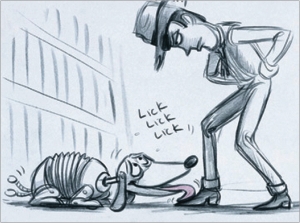 Step 6: Here comes the art department.
Step 6: Here comes the art department.
Now here comes the juice. The storyboard represent the rough character and the actions, its the art department inside Pixar who finalize exactly how the characters are gonna look. The artwork is based on the initial idea treatment and storyboard. But they Go more than that. They brain storm the entire visual world of the animated movie. Which means drawing and designing the furniture, the environment, the costumes etc, you name it. The art department also creates what we should say the “light script” The light script is instruction of how to light the scenes, it is drawn out on layers to indicate the position of virtual light sets.
Step 7: Sculpting it out.
Another section of the art department now receives these detailed drawings to go about creating the characters and everything else in 3D. There are two processes to create the characters. One is to use clay or mud modeling to create the models by hand and then digitize it in a 3D software. The other is to model is directly inside the 3D software. Digitizing is a process by which the model is put over a sensory magnet and points are made on its surface which creates virtual points or vertices in the 3D software.
Another thing they do is to give the characters a bone structure. In Pixar these are called “Avars” or Hinges. Hinges control they way the characters move or the way they change poses. Characters may have hundred of Avars. Remember those really cute looking expressions and the characteristic “Pixar Eyes”? well these are made using morph targets.
Step 8: Laying the Shots.
After finalizing everything, now its time to do the shots. The layout crew choreograph the character movement in the virtual sets using virtual camera. In short, the 2 dimensional story board is translated in 3 dimensions.
Step 9: Lights, Camera, Action!
Finally this is where the tough work begins. Now everything is with the animators. You can compare an animator with a puppeteer, rather than an artist for a 2D cartoon. Of course it isn't as easy as it is said. This is the toughest and the most time consuming process. Unlike traditional 2D cartoons, they don't have to draw each frame. But rather set the key poses and facial expressions and the computer calculates the “in-between” motions.
Step 10: Shading it out.
Once the scenes are acted out. The animation datas now go straight to the tech junkies. The first work is to shade the sets and the characters. In 3D, the surfaces or the skin of the models and characters are separate from the basic geometry, and hence it must go through the shading gurus. It can get even more complex, with the improvement of technology, characters can now have almost true to life hair and fur on their body which flows with the motion of the body (Monster Inc.).
Step 11: Lights Out.
After the shaders are finalized, the files now go through the lighting department. The sets and characters are lit up with virtual lights. Here the same principal of real stage light is followed, that is, key light, fill light, room ambience etc. Remember the colour script thingie I mentioned while talking about art department? This is used extensively here. The lighting is not only done to illuminate but also to create mood.
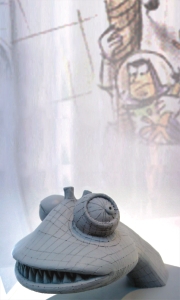 Step 12: Renderman.
Step 12: Renderman.
You guys have heard out renderman, well no, it aint any superhero man like superman or spiderman, it is a rendering software, it uses computers to create high resolution frame by frame of the scenes incorporating light, shader, models, animation etc. On average each frame takes about 6 hours to compute. Some more complex scenes require 10 hours or more. Now think, in one second, there are 24 frames of a film, and in 1 minute there are 60 seconds, the average movies is about 90 to 100 minutes long. Do the math.
Step 13: Final touch.
Straight to the editors board then. The scenes are all cut and pasted together. The voice over clips are attached along with the musical score. Here, some compositing is done and bits and pieces of special effects are added to give a final Midas touch to the movie. And we arrive at the end of our journey.
So that's about it folks! I hope I wasn't so mystifying that nobody would understand a thing. The thing is, movie making is lot more technical than I made it sound. I hope in future will write something about how to go about creating your OWN 3D movie. Crazy cool huh! Oops, I forgot THE MOST IMPORTANT STEP, that is, to go to a theatre, grab a bag of pop corn and enjoy yourself.
School rumble
By Le Chupacabra
26 Episodes, Ages 15+
Harima Kenji, former delinquent and all-round street thug, returns to resume his education at school. Why the sudden change of heart? You just named the reason: his heart. Smitten by Tsukamoto Tenma after having saved her from muggers once before, Harima rejoins school so he can try to win Tenma's (incredibly short-spanned) attention. Tenma on the other hand has her eyes set on the equally oblivious top boy (and resident weirdo), Karasuma Ohto... Let's get ready to rummmbbbble!
School Rumble actually starts off somewhat seriously, making you think for a few moments that it's an intrigueing romance series under the veil of comedy. Kare Kano… eat your heart out!
Okay fine, that's a blatant lie.
It's actually the other way around. Whereas Kare Kano is a more sophisticated, thought-provoking romantic-comedy, School Rumble is its polar opposite. It's all about the laughs in a somewhat asinine, Johnny Bravo kind of way. While the love triangle between Tenma, Harima and Karasuma allows quite a lot of mirth at their expense, the individual characters inevitably steal the show. Class 2-C is comprised of a smorgasbord of (superbly exaggerated) classroom personalities. You have everyone from cup-size comparing perverts to mind readers to ultra-strong female wrestlers and all sorts of other zany characters. It's a great recipe for hilarity with any hint of normalcy being hurled out the window.
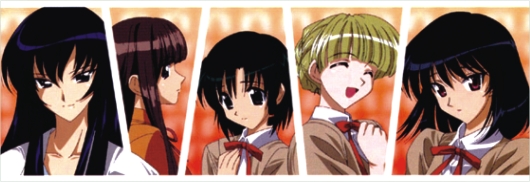
Of course, while they're not considering inane schemes to get one to notice the other, Harima and Tenma's day-to-day antics will have you splitting your sides. Harima is uncharacteristically serious about his feelings for Tenma but his IQ (or lack thereof) is what has him falling into awkward situations. His daydreams of getting Tenma's attention away from Karasuma are the highlight of the show with pop culture parodies of everything from The Matrix to DragonBall Z being liberally thrown into the mix. In fact, it's Harima that brings in most of the laughter. He usually ends up getting into trouble with many of the characters and as a result you've got some genuinely funny moments; there's the one where he has a mistaken identity crisis with a guy named Harry McKenzie (which sounds a lot like Harima Kenji in Japanese), gets into a brawl with the resident black belt Hanai (cue lots of obscure Street Fighter references; HariKen Uppercut anyone?) and of course, as a budding manga artist Harima manages to confuse the viewer with an entire episode where he essentially makes Karasuma an alien. Surprisingly, that incident actually makes sense given how peculiar Karasuma is.
So where does the romance part come into play? It takes more of a latent role since it's essentially the Harima-Tenma-Karasuma love triangle that is the catalyst for much of the insanity. There is a particular point where Harima almost gets his feelings across to Tenma but unfortunately, Eri Sawachika (one of Tenma's best friends) ends up with the message… and returns the feelings. It's an awkward beginning that leads to a pretty interesting relationship. However, events like that are somewhat rare. The problem is, once you've stopped chortling and started to follow the plot, you'll realise something: there is no real plot. The characters, save very few, also don't get developed all too well. Basically, there's a nagging lack of substance which the show covers up, sometimes barely, with the comedy.
Another issue with School Rumble is that its best attribute can also become its biggest detriment. While there is a lot of generally brilliant slapstick to go around, many of the gags are of a greatly esoteric nature while others rely on some knowledge about Japanese school culture. In the fight between Harima (as part of one of his daydreams) and Karasuma, Harima's hair turns yellow and they have a 'power' battle. If you haven't watched DragonBall Z, that bit is completely wasted. There are plenty of examples like that and it's not encouraging for casual anime viewers. Lastly, School Rumble ends up reusing many of jokes as the show wears on. What may have seemed funny at first may end up tasteless after multiple times.
However, with all that said, School Rumble was still brilliantly entertaining. It doesn't take itself seriously at all and at its best, it's outrageously funny. It's still with a bit of caution that I recommend this anime. If you don't like some of jokes initially, chances are you won't like the latter ones. Plus, this anime is quite skewed towards male viewers. If you're a casual fan of anime, you can try this out but also know that there are finer romantic-comedy anime out there. If you've been watching anime for quite some time and are willing to try something that doesn't require you to think too much, you'll certainly enjoy this one at the very least.

Review by Gokhra
Cast:
Ignacio -- Jack Black
Esqueleto -- Hector Jimenez
Sister Encarnacion -- Ana de la Reguera
Guillermo -- Richard Montoya
Jack Black. Now that's a man you can call a walking talking joke and that's a compliment. This guy can make you laugh by simply pirouetting, taking a flying leap, landing all mangled and jumping up to shout something inane. Okay, so that is not all that simple. But this guy is funny in a manner that makes him a living punchline. So when someone brought in the Nacho Libre and popped it into the DVD player it promises to be a good show.
The plot:
The story mainly deals with a bunch of small-town Mexicans who are foolish, noble, absurd and at the same time quite human. Black plays the Mexican character of Ignacio who is a hapless biracial cook (half Scandinavian and half Mexican. He works as a friar at a monastery that houses a bunch of orphan boys. Now money is tight so to finance better meals for the orphans he takes on the job of a luchador. That's wrestling for us folks. It's his dream to be a wrestler except he is not very good at it. He even has a signature move called "the Anaconda squeeze" which you have to see to believe or disbelieve. And he calls himself Nacho (no surprise there eh?)
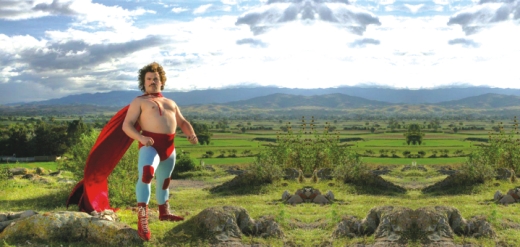
And basically that's really all there is to the plot. The story is helped along with other characters like a toothy street man-urchin called Esqueleto (Hector Jimenez) with whom Ignacio enters the ring. The sidekick and tag-team partner (Hector Jimenez) has a scrawny physique and jelly-lipped grin and manages to get in a few good lines about his faith in science over religion.
``Nacho Libre" also spends a good deal of time with one of the orphans, a pint-size human bowling ball named Chancho (Darius Rose), and a wrestling promoter's obese daughter (Carla Jimenez), who has a crush on Esqueleto and literally tunnels through walls to get at him.
Oh and did I mention the love interest in the form of the beautiful Ana de la Reguera? She appears as the new nun in the monastery playing the character of Sister Incarnacion.
The verdict:
One of the movies most comic moments involves Black singing his love song for her. But for every comic sequence there is a bit of dead air hanging around. Often the story stalls a little making you wonder what step if any it is going to take next. But that's exactly when Black saves the day with one of his idiotic poses or a lunatic body gag. This movie is 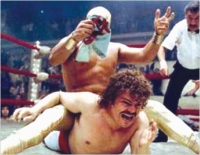 basically one gag about a fat man in a wrestling world expanded into this big screen experience. As a result it falters at times but say what you will, Jack Black manages to carry the movie on his shoulders as the man who will do almost anything for a laugh.
basically one gag about a fat man in a wrestling world expanded into this big screen experience. As a result it falters at times but say what you will, Jack Black manages to carry the movie on his shoulders as the man who will do almost anything for a laugh.
There's plenty of deadpan comedy where on screen characters either speak to you the viewer directly and then there are heavy doses of body-slam. Most of the time the deadpan tone knocks heads with all the head-banging, chair-throwing luchador action.
It has its share of absurd comic sequence such as when Nacho has to fight two midgets in lion costumes resembling deranged little monsters. The image itself is a joke and is carried further by Blacks sense of timing.
In the end it is a mild and very silly comedy but quite enjoyable. Black may be hilarious but just because he is in a movie does not make it awesomely funny (i.e. Envy co-starring Ben Stiller).
